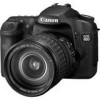Canon 3305211 User Manual - Page 96
Bulb Exposures
 |
UPC - 689076851770
View all Canon 3305211 manuals
Add to My Manuals
Save this manual to your list of manuals |
Page 96 highlights
Bulb Exposures When bulb is set, the shutter stays open while you hold down the shutter button completely, and closes when you let go of the shutter button. This is called bulb exposure. Use bulb exposures for night scenes, fireworks, the heavens, and other subjects requiring long exposures. 1 Set the Mode Dial to . 2 Set the shutter speed to "buLb." While looking at the LCD panel, turn the dial to select "buLb." The next setting after "30"" is "buLb." 3 Set the desired aperture and shoot. To set the aperture, set the power switch to , and turn the dial. While you hold down the shutter button, the exposure will continue. X The elapsed exposure time (sec.) will be indicated on the LCD panel by the same indicator used for the shots remaining. Since bulb exposures have more noise than usual, the image may look rough or grainy. When [8C.Fn II -1] (Long exp. noise reduction) is set to [1:Auto] or [2:On], noise generated by the bulb exposure can be reduced. (p.156) For bulb exposures, using Remote Switch RS-80N3 or Timer Remote Controller TC-80N3 (both sold separately) is recommended. U LCD Panel Illumination Each time you press the button, the LCD panel illumination will turn on or off (9). During a bulb exposure, pressing the shutter button completely will turn off the LCD panel illumination. 96















